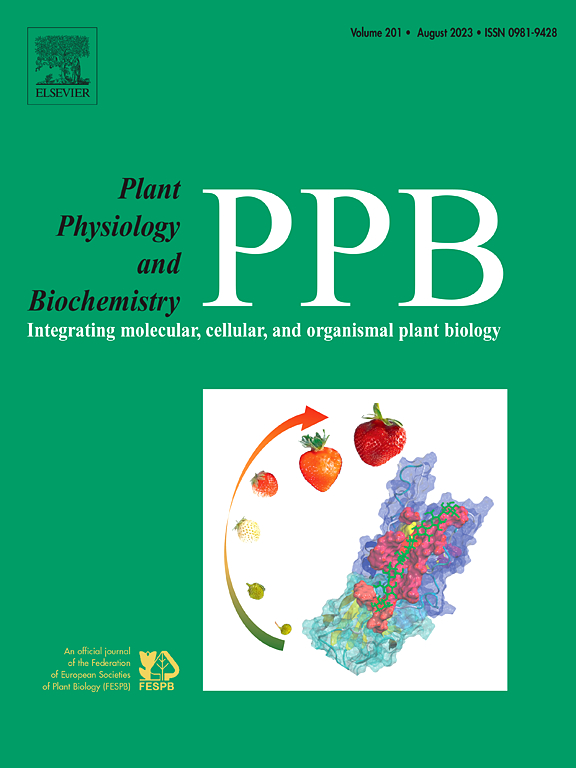Integrated genomic, transcriptomic, and metabolomic analyses provide novel insights into high cadmium accumulation in Phytolacca icosandra L
IF 6.1
2区 生物学
Q1 PLANT SCIENCES
引用次数: 0
Abstract
The evolutionary features and molecular basis of the conserved abilities of Phytolacca species to accumulate cadmium (Cd) and manganese (Mn) are poorly understood. In this study, the chromosomal-level genome of P. icosandra (2n = 2x = 36) was sequenced and assembled. The genome has a size of 1042.86 Mb, with a contig N50 of 52.37 Mb and a GC content of 38.17%. Genomic evaluation revealed that the P. icosandra genome contains 98.95% of BUSCO and achieves an LAI score of 15.45. Genome annotation indicated that the P. icosandra genome encompasses 25,756 protein-coding genes. Evolutionary analysis identified one recent whole genome duplication event and showed that the unique, significantly expanded, and positive selection genes in P. icosandra were markedly enriched in various functional categories (e.g., zinc ion binding, Mn ion binding, nicotianamine biosynthetic process) associated with metal (e.g., Cd and Mn) responses. Furthermore, several of these evolution-related genes were significantly upregulated by 25 and 100 μM Cd stress. Among them, an expanded gene PiNAS-l significantly improved Cd tolerance in the Δycf1 yeast strain. These results indicate that the high-Cd-accumulating characteristics of P. icosandra may be driven by evolutionary selection. Integrated physiological, transcriptomic, and metabolomic analyses revealed that several key processes, including Cd transport, signal transduction, lignin- and flavonoid-biosynthesis, and carbohydrate metabolism, contributed to Cd detoxification in P. icosandra roots. These processes were likely regulated by multiple transcription factor networks involving in WRKY, ERF, MYB, bHLH, bZIP, and several other families. This study provides the first chromosomal-level genome of Phytolaccaceae species and offers novel insights into Cd tolerance and accumulation in plants from evolutionary and molecular perspectives.
综合基因组学、转录组学和代谢组学分析为植物高镉积累提供了新的见解
植物积累镉(Cd)和锰(Mn)的保守能力的进化特征和分子基础尚不清楚。本研究对P. icosandra (2n = 2x = 36)染色体水平基因组进行了测序和组装。基因组大小为1042.86 Mb, contig N50为52.37 Mb, GC含量为38.17%。基因组鉴定结果显示,黄颡鱼基因组含有98.95%的BUSCO, LAI为15.45。基因组注释表明,白杨的基因组包含25,756个蛋白质编码基因。进化分析发现了最近发生的一个全基因组重复事件,并表明在与金属(如Cd和Mn)反应相关的各种功能类别(如锌离子结合、锰离子结合、烟胺生物合成过程)中显著富集了独特的、显著扩增的阳性选择基因。此外,其中一些进化相关基因在25 μM和100 μM Cd胁迫下显著上调。其中,扩增的基因pinas - 1显著提高了Δycf1酵母菌的Cd耐受性。这些结果表明,黄杨的高cd积累特性可能是由进化选择驱动的。综合生理学、转录组学和代谢组学分析表明,包括Cd转运、信号转导、木质素和类黄酮生物合成以及碳水化合物代谢在内的几个关键过程都有助于白杨根的Cd解毒。这些过程可能受到多个转录因子网络的调控,包括WRKY、ERF、MYB、bHLH、bZIP和其他几个家族。该研究提供了植物科物种的第一个染色体水平基因组,并从进化和分子角度对植物的Cd耐受性和积累提供了新的见解。
本文章由计算机程序翻译,如有差异,请以英文原文为准。
求助全文
约1分钟内获得全文
求助全文
来源期刊
CiteScore
11.10
自引率
3.10%
发文量
410
审稿时长
33 days
期刊介绍:
Plant Physiology and Biochemistry publishes original theoretical, experimental and technical contributions in the various fields of plant physiology (biochemistry, physiology, structure, genetics, plant-microbe interactions, etc.) at diverse levels of integration (molecular, subcellular, cellular, organ, whole plant, environmental). Opinions expressed in the journal are the sole responsibility of the authors and publication does not imply the editors'' agreement.
Manuscripts describing molecular-genetic and/or gene expression data that are not integrated with biochemical analysis and/or actual measurements of plant physiological processes are not suitable for PPB. Also "Omics" studies (transcriptomics, proteomics, metabolomics, etc.) reporting descriptive analysis without an element of functional validation assays, will not be considered. Similarly, applied agronomic or phytochemical studies that generate no new, fundamental insights in plant physiological and/or biochemical processes are not suitable for publication in PPB.
Plant Physiology and Biochemistry publishes several types of articles: Reviews, Papers and Short Papers. Articles for Reviews are either invited by the editor or proposed by the authors for the editor''s prior agreement. Reviews should not exceed 40 typewritten pages and Short Papers no more than approximately 8 typewritten pages. The fundamental character of Plant Physiology and Biochemistry remains that of a journal for original results.

 求助内容:
求助内容: 应助结果提醒方式:
应助结果提醒方式:


